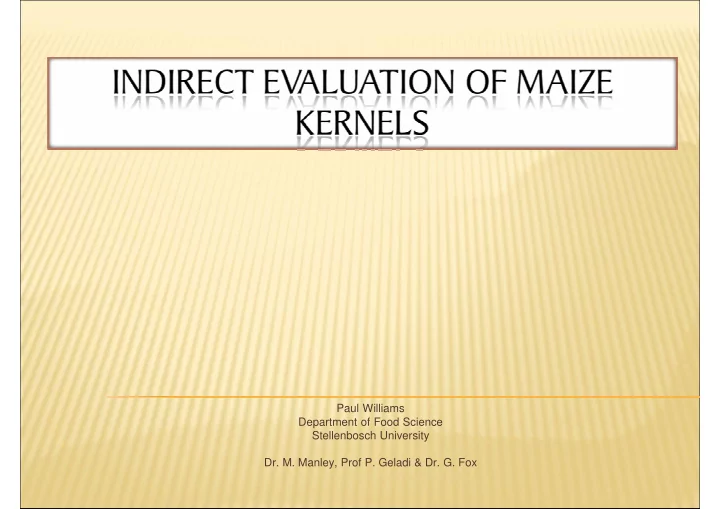

Paul Williams Department of Food Science Stellenbosch University Dr. M. Manley, Prof P. Geladi & Dr. G. Fox
Objective � What is NIR hyperspectral imaging? � How does it work? � Maize Hardness � Fumonisins � Concluding remarks �
The global objective of my project is to find localised chemical � differences in maize using NIR hyperspectral imaging, in so doing studying the quality and food safety aspects of natural products.
Combination of single-point NIR spectroscopy and digital imaging � Able to collect both spectral and spatial information simultaneously in � one rapid measurement In contrast to digital imaging that captures a complete set of information � regarding an object in only three layers, red, green and blue (RGB), NIR hyperspectral imaging acquires data pertaining the object in many wavelengths, depending on the instrument. It is not only capable of identifying the chemical species and � determining the concentration present in a sample, but it is also able to indicate location.
(Burger, 2006)
(Burger, 2006)
(Gowen, 2007)
Spectral Dimensions Digital image of maize samples Matrix NIR instrument
Raw NIR hyperspectral Digital image image (960 nm)
Classification image PCA Score plot (81 920 pixels)
7.28% 92.11% PCA Score image PCA Score plot (23 798 remaining pixels)
0.58% 7.28%
PC 2 loading line plot 0.14 hard endosperm Starch, H 2 O 0.12 Protein soft endosperm 0.10 0.08 0.06 Starch, H 2 O 0.04 Arbitrary units 0.02 0.00 -0.02 -0.04 Starch -0.06 -0.08 -0.10 -0.12 Starch -0.14 960 1020 1080 1140 1200 1260 1320 1380 1440 1500 1560 1620 Wavelength (nm)
PC 3 loading line plot 0.25 hard endosperm Starch 0.20 soft endosperm 0.15 Starch 0.10 0.05 Arbitrary units 0.00 -0.05 -0.10 -0.15 -0.20 H 2 O -0.25 960 1020 1080 1140 1200 1260 1320 1380 1440 1500 1560 1620 Wavelength (nm)
Modelled Not modelled � Four PLS components were adequate to model 2 6 1 3 4 5 85% of the variation within the data (Fig. 3a). (a) Explained variation (R 2 ) � after 6 PLS components After 2 PLS components most of the floury endosperm was explained in the model (Fig. 3b). � Four PLS components were necessary to model the glassy endosperm (Fig. 3c).
0.12 p[2] non-infected Starch p[2] infected 0.08 H 2 O 0.04 Protein Arbitrary Value 0.00 -0.04 Starch -0.08 -0.12 -0.16 990 1050 1110 1170 1230 1290 1350 1410 1470 1530 1590 Wavelength (nm) Loading line plot for PC2
0.25 p[4] non-infected p[4] infected 0.20 Starch 0.15 0.10 Arbitrary Value Oil 0.05 0.00 -0.05 -0.10 Protein -0.15 H 2 O Protein -0.20 990 1050 1110 1170 1230 1290 1350 1410 1470 1530 1590 Wav elength (nm) Loading line plot for PC4
It is possible to distinguish between hard and soft maize using NIR � hyperspectral imaging. NIR hyperspectral imaging can be used to indirectly determine the � possible presence of fumonisins on maize kernels. Images on a longer wavelength instrument has been acquired and � evaluated. The software package limits us to applying the calibration equation to � new sample sets.
Recommend
More recommend